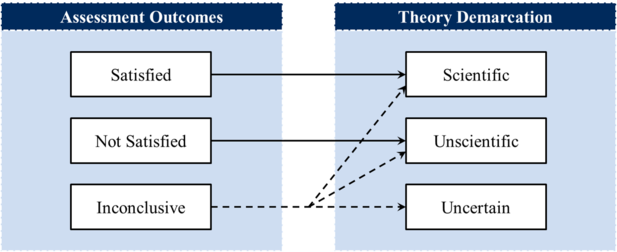Mechanism of Compatibility
Under what conditions can two elements coexist in the same mosaic?
While some theories can coexist in the same mosaic, others seem to be incompatible. So the task is to understand when two theories (or two methods) can and when they cannot coexist in the same mosaic.
In the scientonomic context, this question was first formulated by Hakob Barseghyan and Rory Harder in 2015. The question is currently accepted as a legitimate topic for discussion by Scientonomy community.
In Scientonomy, the accepted answer to the question is:
- If a pair of elements satisfies the compatibility criteria employed at the time, it becomes compatible within the mosaic; if it does not, it is deemed incompatible; and if assessment is inconclusive, the pair can become compatible, incompatible, or its status may be unknown.
Contents
Scientonomic History
Acceptance Record
| Community | Accepted From | Acceptance Indicators | Still Accepted | Accepted Until | Rejection Indicators |
|---|---|---|---|---|---|
| Scientonomy | 1 January 2016 | This is when the community accepted its first answer to the question, The Zeroth Law (Harder-2015), which indicates that the question is itself considered legitimate. | Yes |
All Theories
| Theory | Formulation | Formulated In |
|---|---|---|
| The Zeroth Law (Harder-2015) | At any moment of time, the elements of the scientific mosaic are compatible with each other. | 2015 |
| The Law of Compatibility (Fraser-Sarwar-2018) | If a pair of elements satisfies the compatibility criteria employed at the time, it becomes compatible within the mosaic; if it does not, it is deemed incompatible; and if assessment is inconclusive, the pair can become compatible, incompatible, or its status may be unknown. | 2018 |
If an answer to this question is missing, please click here to add it.
Accepted Theories
| Community | Theory | Accepted From | Accepted Until |
|---|---|---|---|
| Scientonomy | The Zeroth Law (Harder-2015) | 1 January 2016 | 3 June 2020 |
| Scientonomy | The Law of Compatibility (Fraser-Sarwar-2018) | 9 October 2021 |
Suggested Modifications
| Modification | Community | Date Suggested | Summary | Verdict | Verdict Rationale | Date Assessed |
|---|---|---|---|---|---|---|
| Sciento-2018-0018 | Scientonomy | 28 December 2018 | Accept the new dynamic law of compatibility which specifies how exactly two elements become to be considered compatible or incompatible within a mosaic. | Accepted | It was agreed that the "modification provides a great addition to the current body of scientonomic knowledge"c1 as the law offers "a dynamic account of compatibility"c2 and "allows for a diachronic study of compatibility".c3 The law was praised for its non-tautological nature, since it "forbids a number of logically conceivable scenarios".c4 While finding the law acceptable, one of the commentators raised an important question for future scientonomic research: do we even need a separate law of compatibility? Specifically they asked: "Is assessment for compatibility with other elements of the mosaic really conceptually distinct from the process of assessment for theory acceptance, which is already covered by other scientonomic laws?"c5 On this view, "the issue of the conceptual separability of theory compatibility and theory acceptance, and thus the need for two parallel laws, remains an open question that warrants further investigation".c6 | 9 October 2021 |
Current View
In Scientonomy, the accepted answer to the question is The Law of Compatibility (Fraser-Sarwar-2018).
The Law of Compatibility (Fraser-Sarwar-2018) states: "If a pair of elements satisfies the compatibility criteria employed at the time, it becomes compatible within the mosaic; if it does not, it is deemed incompatible; and if assessment is inconclusive, the pair can become compatible, incompatible, or its status may be unknown."
The law of compatibility links the compatibility criteria with various assessment outcomes. If compatibility is defined as the ability of a pair of elements to co-exist in the same mosaic, then the assessment for compatibility is essentially the process by which the epistemic agent decides whether any given pair of elements (i.e. theories, questions, methods) can be simultaneously part of their mosaic. Such an assessment can yield three possible outcomes - satisfied, not satisfied, and inconclusive.1p. 73 Accordingly, the law of compatibility states that if a pair of elements does satisfy the compatibility criteria of the time, then it is deemed as compatible. If, however, an element is taken to be incompatible with the other one, then the pair is deemed as incompatible. Finally, the assessment of compatibility may be inconclusive. In this case, the pair may be deemed compatible, incompatible, or its status may remain unknown. The diagram below summarizes the relation between assessment outcomes and their effects:
Related Topics
This question is a subquestion of Mechanism of Scientific Change.
It has the following sub-topic(s):
References
- ^ Fraser, Patrick and Sarwar, Ameer. (2018) A Compatibility Law and the Classification of Theory Change. Scientonomy 2, 67-82. Retrieved from https://scientojournal.com/index.php/scientonomy/article/view/31278.

